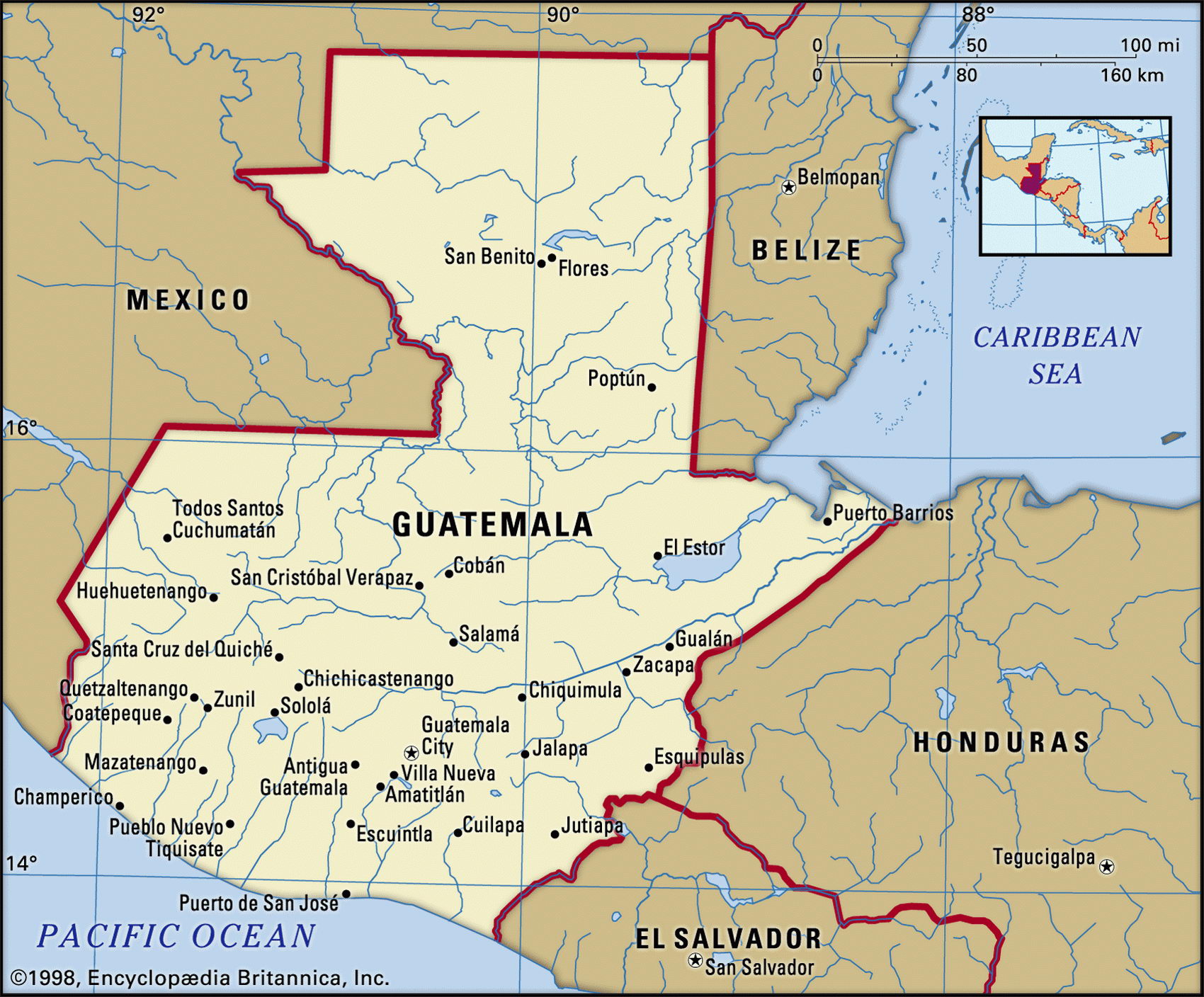Map of Guatemala and geographical facts
Map of Guatemala with cities. Guatemala on the world map
Map of Guatemala with cities. Where Guatemala is on the world map. The main geographical facts about Guatemala - population, country area, capital, official language, religions, industry and culture.

Guatemala Fact File
Official name Republic of Guatemala
Form of government Republic with single legislative body (Congress of the Republic)
Capital Guatemala
Area 108,890 sq km (42,042 sq miles)
Time zone GMT-6 hours
Population 13,314,000
Projected population 2015 16,329,000
Population density 122.3 per sq km (316.7 per sq mile)
Life expectancy 66.9
Infant mortality (per 1,000) 44.6
Official language Spanish
Other languages 23 Maya Quiche languages
Literacy rate 63.6%
Religions Roman Catholic 75 %, Protestant 25 %; some traditional Mayan beliefs
Ethnic groups Mixed indigenous-European 56%, indigenous 44%
Currency Quetzal
Economy Agriculture 50%, services 38%, industry 12%
GNP per capita US$ 3,700
Climate Tropical, but cooler in highlands
Highest point Volcan Tajumulco 4,220 m (13,845 ft)
Map reference Page 428
Guatemala lies just south of Mexico, and is the most populous of the Central American states. It was once part of the home of the Mayan civilization which reached its peak about ad 300-900. It has numerous volcanoes, including Tajumulco, the highest peak in Central America. In 1523 the region was overrun by Spanish conquistadors. As elsewhere in Central and South America, the newly arrived Spanish established large agricultural estates worked by Amerindian laborers, setting the social and economic pattern for 300 years. After becoming a republic in 1839, Guatemala has had a history of dictatorship, coups d'etat, and guerrilla insurgency. Profound social divisions exist between the Amerindian majority, and an elite of mixed Spanish and Amerindian ancestry (called Ladinos) who run the government. Guatemala has had civilian rule since 1985. In 1996 a United Nations mediated accord was signed by President Alvaro Arzu and the members of the URNG guerrilla movement which it is hoped will bring an end to 36 years of armed struggle.
Two large mountain ranges cross the heart of the country. In the north are the older and more eroded Altos Cuchumatanes. To the south the geologically younger Sierra Madre Range includes 33 volcanoes, of which three are still active. Soil enriched with volcanic ash washed down from the Sierra Madre has created a narrow but fertile plain on the Pacific coast. This has been used for agriculture on a commercial scale only since the 1950s, when malaria was first brought under control and access roads were built. Now cattle and cotton are more important than this region's traditional banana crop. On the lower mountain slopes, up to about 1,500 m (5,000 ft), most of the country's highest quality coffee is grown. In the north of Guatemala the highlands fall away to the large, flat, forested Peten Tableland, where many ancient Mayan ruins are found, and to the plains along the Gulf of Honduras.
Guatemala's economy is largely agricultural. Coffee is the main crop and chief export, other exports being sugar, bananas, cardamom, and beef. From the forests, now reduced to about forty percent of the country's land area, come timber and chicle, the gum used for chewing gum. The country has few mineral or energy reserves, apart from small amounts of petroleum, and until recently guerrilla activity has hindered access to the wells. Industries include sugar refining, furniture, chemicals, metals, rubber, textiles and clothing, and tourism. Tourism, largely comprising visits to the Maya ruins, revived after the military activities of the 1980s but fell into decline again in 1994 and 1995 following attacks on foreigners. From 1990 the economy has shown mild but consistent growth though, given the extreme disparity of wealth, the government faces many difficulties in implementing its program of modernization and the alleviation of poverty.